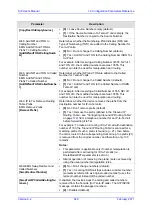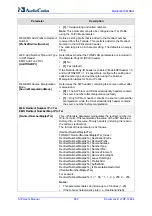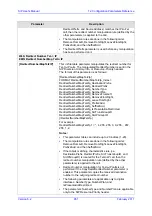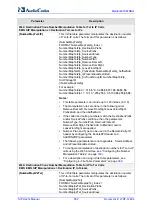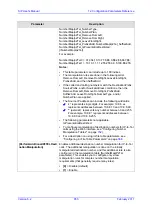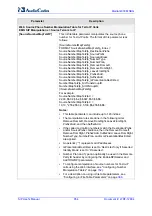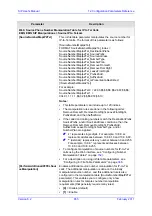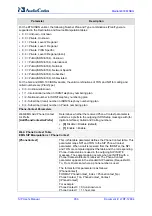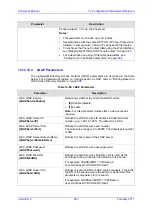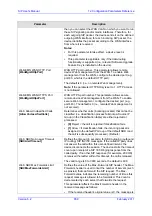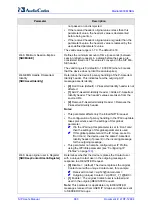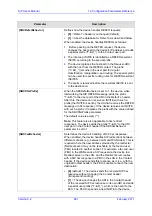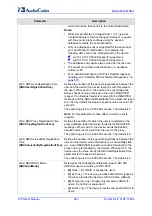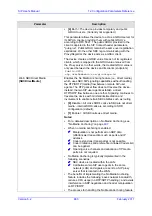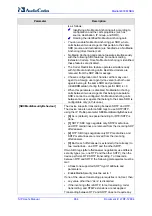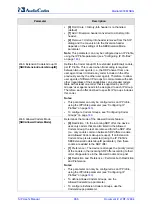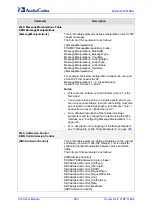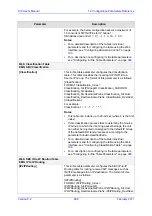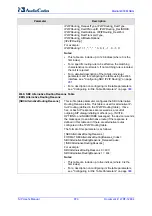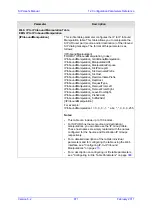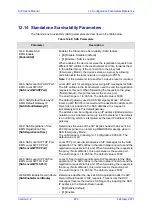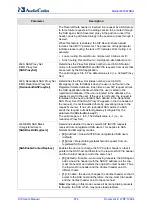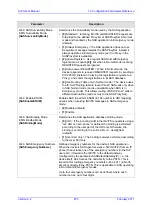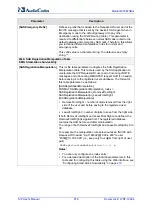
Version 6.2
863
February 2011
SIP User's Manual
12. Configuration Parameters Reference
Parameter
Description
[4]
Both = The device provides temporary and public
GRUU to users. (Currently not supported.)
This parameter allows the device to act as a GRUU server for
its SIP UA clients, providing them with public GRUU’s,
according to RFC 5627. The public GRUU provided to the
client is depicted in the SIP Contact header parameters,
"pub-gruu". Public GRUU remains the same over registration
expirations. On the other SBC leg communicating with the
Proxy/Registrar, the device acts as a GRUU client.
The device creates a GRUU value for each of its registered
clients, which is mapped to the GRUU value received from
the Proxy server. In other words, the created GRUU value is
only used between the device and its clients (endpoints).
Public-GRUU:
sip:[email protected];gr=unique-id
Web: SBC Direct Media
[SBCDirectMedia]
Enables the No Media Anchoring feature (i.e., direct media),
which uses SBC SIP signaling capabilities without handling
the RTP/SRTP (media) flow between remote SIP user
agents. The RTP packet flow does not traverse the device,
instead, the two SIP user agents establish a direct
RTP/SRTP flow between one another. Signaling continues to
traverse the device with minimal intermediation and
involvement to enable certain SBC abilities such as routing
[0]
Disable = All cross SRD's calls via SBC are not direct
media - internal SRD calls are according to SRD
configuration (default).
[1]
Enable = All SBC calls use direct media.
Notes:
For a detailed description on No Media Anchoring, see
''No Media Anchoring'' on page
When no media anchoring is enabled:
9
Manipulation is not performed on SDP data
(offer/answer transaction) such as ports and IP
address.
9
Coder extensions (transcoding) is not possible.
9
Coder limitations and preference (Allowed Coders list)
can be applied.
9
Opening voice channels and allocation of IP media
ports are not required.
No Media Anchoring is typically implemented in the
following scenarios:
9
SBC device is located within the LAN.
9
Call between two SIP user agents in the same
network (LAN) and signals are sent to a SIP proxy
server that is located in the WAN.
The benefits of implementing the No Media Anchoring
feature includes the following: saves network bandwidth,
reduces CPU usage (no RTP/SRTP handling), and avoids
interference in SDP negotiation and header manipulation
on RTP/SRTP.
The process for handling the No Media Anchoring feature
Содержание Mediant 800 MSBG
Страница 2: ......
Страница 366: ...SIP User s Manual 366 Document LTRT 12804 Mediant 800 MSBG Reader s Notes ...
Страница 372: ...SIP User s Manual 372 Document LTRT 12804 Mediant 800 MSBG Reader s Notes ...
Страница 390: ...SIP User s Manual 390 Document LTRT 12804 Mediant 800 MSBG Reader s Notes ...
Страница 404: ...SIP User s Manual 404 Document LTRT 12804 Mediant 800 MSBG Reader s Notes ...
Страница 616: ...SIP User s Manual 616 Document LTRT 12804 Mediant 800 MSBG Reader s Notes ...
Страница 636: ...SIP User s Manual 636 Document LTRT 12804 Mediant 800 MSBG Reader s Notes ...
Страница 652: ...SIP User s Manual 652 Document LTRT 12804 Mediant 800 MSBG Reader s Notes ...
Страница 886: ...SIP User s Manual 886 Document LTRT 12804 Mediant 800 MSBG Reader s Notes ...
Страница 890: ...User s Manual Ver 6 2 www audiocodes com ...

